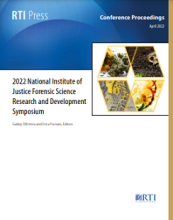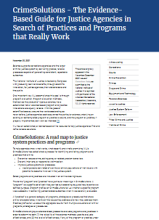Criminal justice agencies
Can body-worn cameras reduce injuries during response-to-resistance events in a jail setting? Results from a randomized controlled trial
A longitudinal cohort mixed methods study of the impact of mental health on retention and turnover among early career police officers in South Carolina
FIU - Forensic Technology Center of Excellence
Empirical Analysis of Saw Mark Characteristics in Human Bone: Meeting Forensic Standards in Dismemberment Cases
Implementation of NPS Discovery – An Early Warning Systems for Novel Drug Intelligence, Surveillance, Monitoring, Response, and Forecasting using Drug Materials and Toxicology Populations in the US
Criminal justice forecasts of risk: A machine learning approach
Machine learning risk assessments in criminal justice settings
Effects of county and state economic, social, and political contexts on racial/ethnic and gender differences in youth's penetration into the justice system
Can PSM Strategies Replicate RCT Results in Criminal Justice Research?
Desistance from Crime: Interventions to Help Promote Desistance and Reduce Recidivism
No single criminal justice agency can promote desistance on its own. Partnerships across state, local, and federal agencies — along with the support of family and community stakeholders — are instrumental in supporting desistance from crime and reducing recidivism.
Law enforcement, courts, corrections, and community supervision agencies play a key role in the desistance process and reducing recidivism.
See the YouTube Terms of Service and Google Privacy Policy
Implementation of NPS Discovery – An Early Warning Systems for Novel Drug Intelligence, Surveillance, Monitoring, Response, and Forecasting using Drug Materials and Toxicology Populations in the US
FIU - Forensic Technology Center of Excellence
Collaborative Innovations Will Lead Corrections Into the Future
Conference Proceedings: 2022 National Institute of Justice Forensic Science Research and Development Symposium
The Hidden Costs of Reentry: Understanding the Barriers to Removing a Criminal Record
NIJ hosted a webinar to discuss under-researched aspects of reentry: expungement of criminal records and the impact of those records. This webinar includes a presentation of ongoing research projects examining the impact of legal aid for expungement and past research projects studying the accuracy and permanency of criminal records and the prevalence of collateral consequences of conviction. A Q&A session will conclude this webinar.
See the YouTube Terms of Service and Google Privacy Policy
Desistance: It's a Process, Not an Event
Multilevel Evaluation of Project Safe Neighborhoods
Project Safe Neighborhoods (PSN) is a DOJ-sponsored initiative to reduce violent crime, particularly gun crime, by fostering cooperation by criminal justice agencies and local partners to develop and implement strategic approaches.
See the YouTube Terms of Service and Google Privacy Policy
The University of Alabama System and the Alabama Department of Forensics National Center on Forensics
CrimeSolutions - The Evidence-based Guide for Justice Agencies in Search of Practices and Programs that Really Work
Desistance From Crime: Implications for Research, Policy, and Practice
Most scholars would agree that desistance from crime – the process of ceasing engagement in criminal activities – is normative. However, there is variability in the literature regarding the definition and measurement of desistance, the signals of desistance, the age at which desistance begins, and the underlying mechanisms that lead to desistance. Even with considerable advances in the theoretical understanding of desistance from crime, there remain critical gaps between research and the application of that research to practice.
See the YouTube Terms of Service and Google Privacy Policy
FIU - Forensic Technology Center of Excellence
Multilevel Evaluation of Project Safe Neighborhoods






